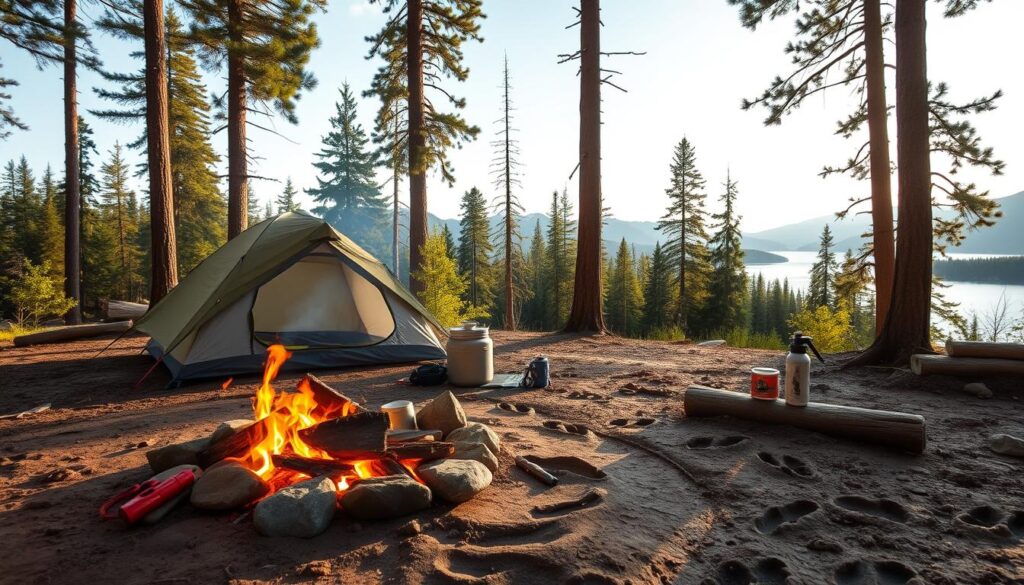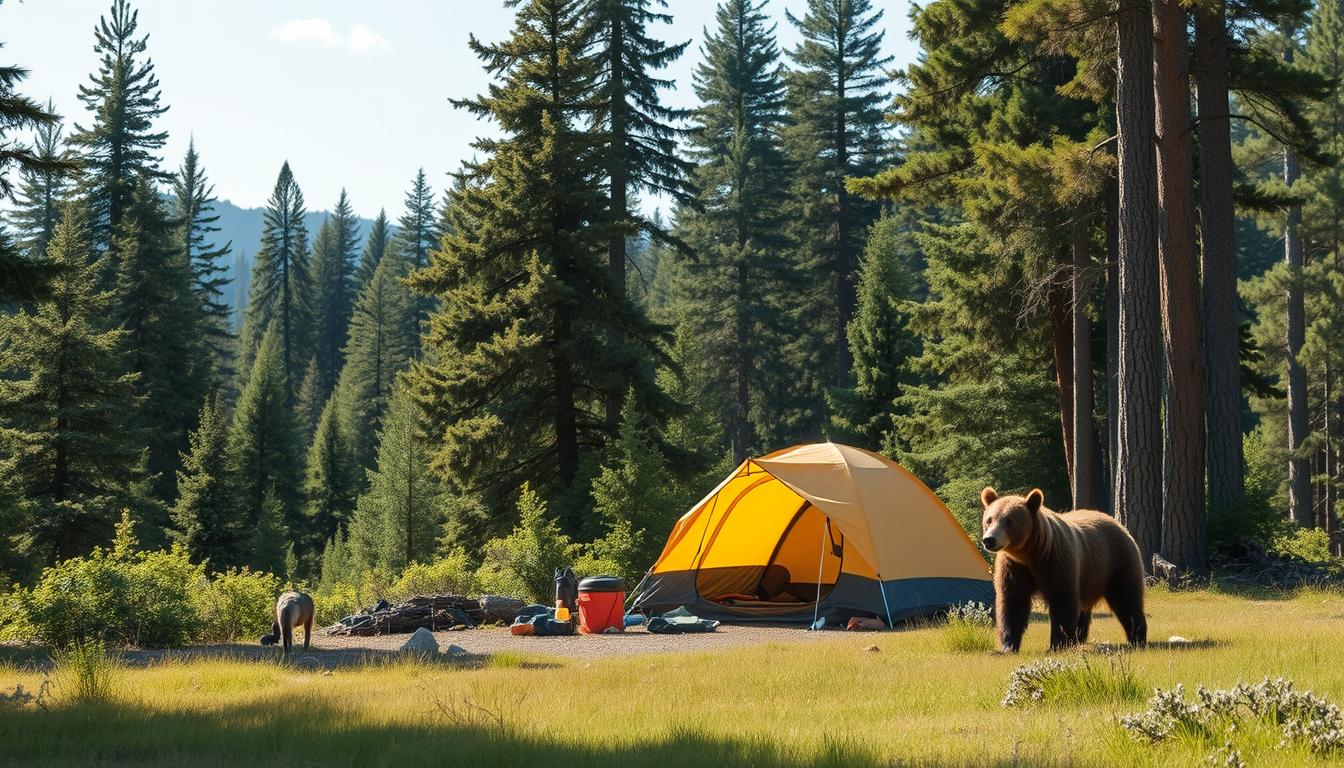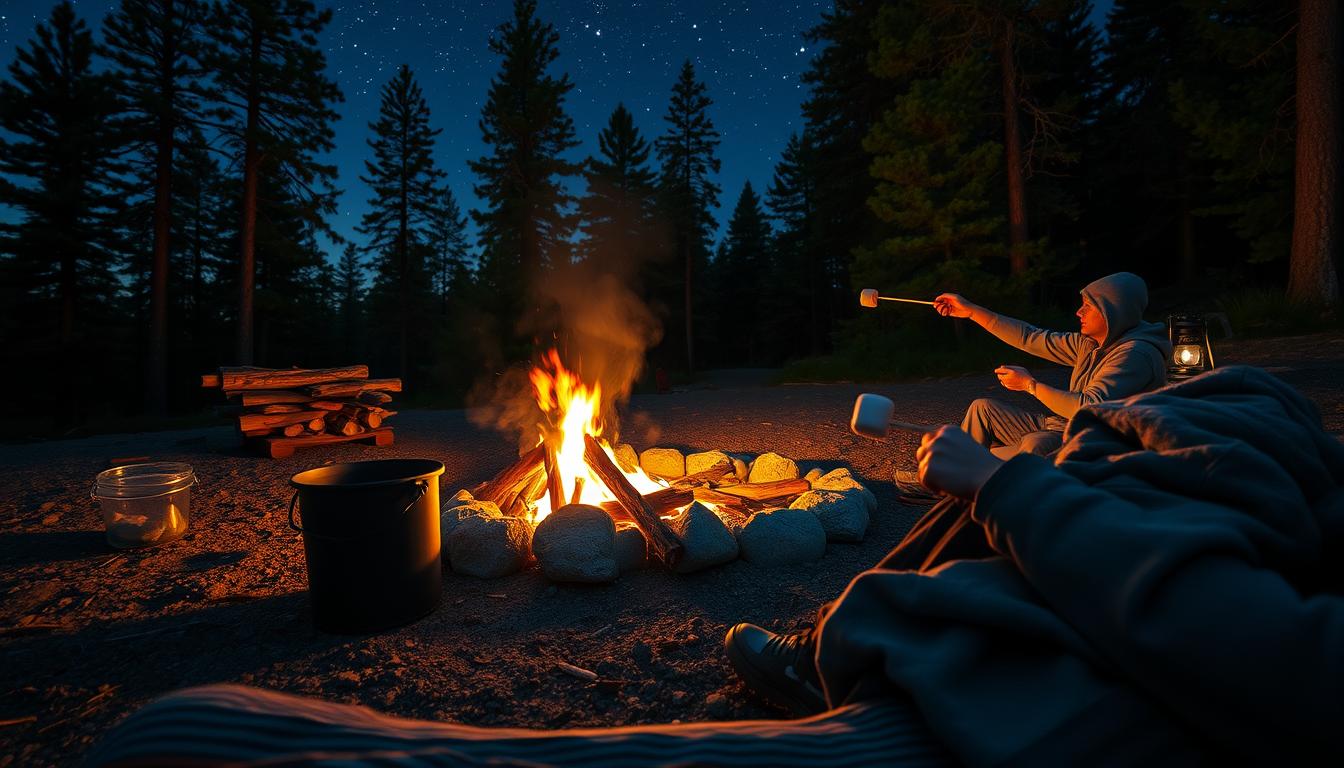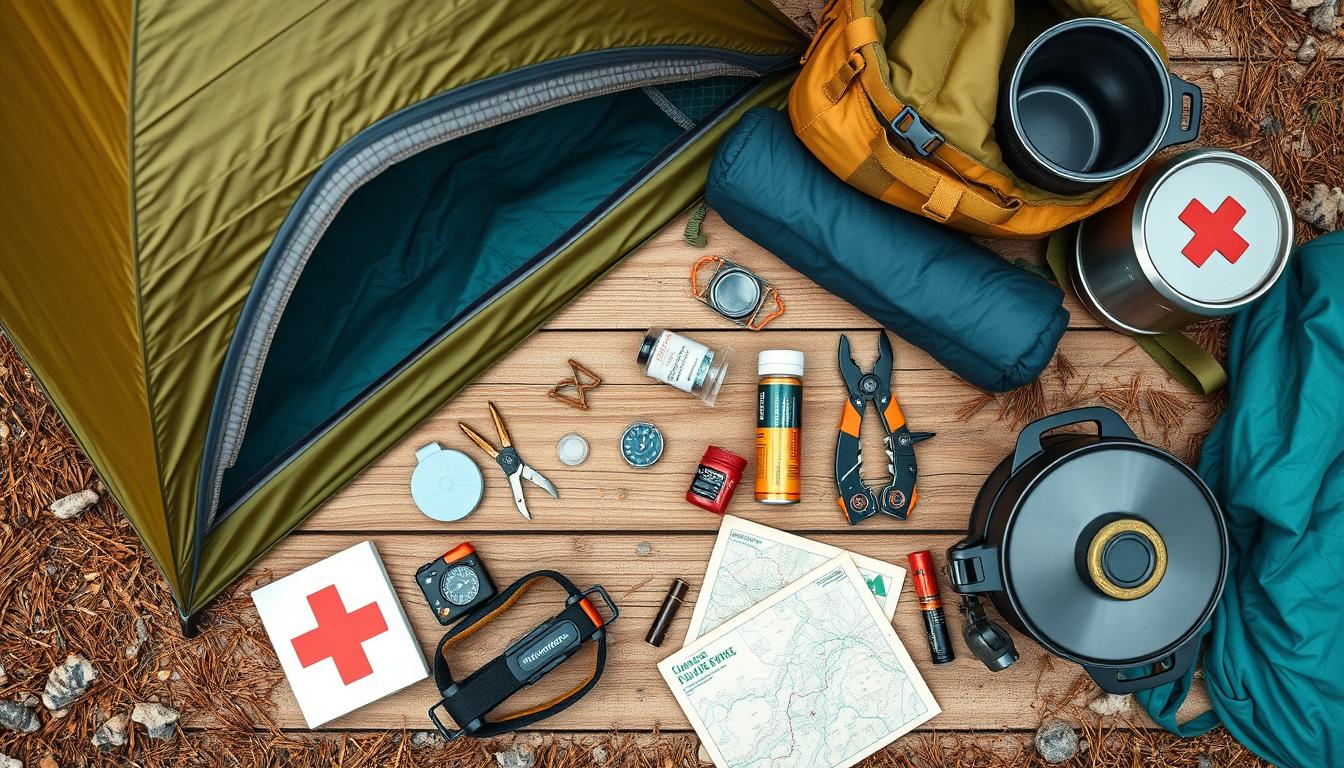Camping is a rewarding outdoor activity, but it has its risks, especially with wildlife. I love the outdoors and know how important it is to be ready for wildlife. Knowing how to handle bears and other animals is key to a safe camping trip.
Preparation and being aware are essential for a safe camping experience. I’ll share important tips on camping safety, like understanding animal behavior. This way, I can enjoy the wilderness without worrying about wildlife.
Key Takeaways
- Understanding wildlife behavior is crucial for safe camping experiences.
- Preparation can prevent negative wildlife encounters.
- Knowing how to deal with bears and other wildlife boosts camping safety.
- A proper campsite can minimize wildlife interactions.
- Awareness of local wildlife enhances outdoor enjoyment.
Understanding Wildlife Encounters in Camping Areas
Wildlife encounters can make camping better, but they also have risks. It’s key to know about wildlife to stay safe. By learning about animal behaviors and habitats, I can better prepare and reduce risks.
The Importance of Wildlife Awareness
Knowing the wildlife in my area helps me prepare for encounters. Understanding animal habits is vital. For example, raccoons like food scraps, and deer may visit campsites. This knowledge helps me stay safe and respect wildlife.
Common Animals Encountered While Camping
While camping, I might see many animals. Here are some I should watch out for:
| Animal | Description | Common Behavior |
|---|---|---|
| Bears | Large mammals, typically brown or black. | Active foraging, often seeking food sources. |
| Deer | Graceful animals with antlers found in forested areas. | Wandering near campsites, particularly at dawn or dusk. |
| Raccoons | Intelligent, nocturnal creatures known for their masked faces. | Searching for food, especially rummaging through bags or garbage. |
| Opossums | Small marsupials often recognized by their unique appearance. | Scavenging for food scraps or fruits. |
| Birds | Variety of species, often attracted by food or song. | Feeding in campsites or nearby trees. |
Knowing about wildlife encounters makes camping better and safer. For more tips, I can check out resources like the article on managing animal behavior while camping.
Camping in Bear Country: What You Need to Know
Exploring areas with bears means knowing the environment well. Learning about bear habitats and behavior boosts my safety. This knowledge helps me avoid surprises.
Identifying Bear Habitats
Bears prefer certain places for food and shelter. Knowing these spots helps me choose the right campsite:
- Dense Woodlands: Bears like thick forests for hiding and finding food.
- Near Water Sources: Rivers, lakes, and streams offer water and fish.
- Berry Patches: Summer and early fall, bears go for berries.
Understanding Bear Behavior
Knowing how bears act helps keep my camping safe. I watch for these behaviors:
- Feeding Patterns: Bears hunt in the morning and evening.
- Mating Season: May to July, bears are more aggressive.
- Protective Instincts: Mother bears with cubs are very protective.
Adding bear safety tips to my camping plans helps a lot. Knowing these behaviors is key for anyone in bear country.
How to Deal with Bears and Other Wildlife While Camping
When you’re camping, knowing how to handle bears and other wildlife is key for a safe trip. By taking the right steps, you can avoid encounters and be ready for any surprises. Here, I’ll share important tips for preventing wildlife encounters and what to do if you meet one.
Preventative Measures to Avoid Encounters
Effective camping precautions can greatly reduce wildlife encounters. Here are some essential steps to take:
- Proper food storage: Keep food in bear-resistant containers and away from your sleeping area.
- Choose the right campsite: Camp in designated areas, far from wildlife paths and foraging zones.
- Maintain a clean environment: Dispose of trash correctly and avoid leaving food scraps around.
- Keep a safe distance: Watch wildlife from afar, never approach them or their dens.
What to Do If You Encounter a Bear
If I meet a bear, staying calm is crucial. Here are some important tips:
- Do not run: Running can make the bear chase you. Instead, back away slowly while facing it.
- Use bear spray: If the bear comes closer, bear spray can help deter it.
- Make yourself appear larger: Raise your arms or backpack above your head to look bigger.
- Speak firmly: Use a calm but firm voice to remind the bear you’re human.

Camping Safety: Essential Gear for Wildlife Protection
When planning a camping trip, safety should be your top priority, especially in areas with bears. The right gear and a good campsite location make your trip safer and more fun. Here are some key tips for setting up your campsite and storing food.
Choosing the Right Tent and Campsite Location
It’s important to pick a strong, quality tent to protect against wildlife. My tent must be tough enough to handle animal interactions but still keep me comfortable. Here are some tips for choosing the best campsite:
- Place your tent far from trails and thick bushes to avoid wildlife.
- Choose a spot that’s high and dry to keep animals away.
- Find a campsite with natural barriers to animal paths.
- Set up at least 200 feet from water to avoid animal gatherings.
Bear-Resistant Food Storage Options
Keeping food safe is key to camping safety. Using bear-resistant food storage methods helps avoid wildlife risks. Here are my go-to options:
- Bear Canisters: These strong containers keep food safe from bears.
- Bear Bags: These bags are light, strong, and can be hung from trees. Hang them 10 feet up and 4 feet from the trunk.
- Coolers: Make sure all food in coolers is sealed tight. Some coolers have bear-resistant features.
By following these food storage tips and choosing the right campsite, I stay safe and enjoy nature more. These practices give me peace of mind while camping.
Bear Safety Tips for Campers and Hikers
It’s crucial to be ready for bear encounters when outdoors. By using bear safety tips, you can stay safe and enjoy nature more. These tips help reduce risks and make your outdoor adventures better.
Using Bear Spray Effectively
Bear spray is a key tool for protecting yourself from wildlife. Here are some tips to make sure it works:
- Choose the Right Spray: Pick a bear spray with at least 0.7% capsaicin.
- Know the Range: Bear spray works best up to 25 to 30 feet away. Practice using it safely.
- Aim for the Face: Spray the bear’s face to block its path.
- Deploy Before the Bear Gets Too Close: Spray when the bear is 30 feet away. Only spray when it approaches.
- Practice Use: Get familiar with your bear spray before going into the wild. This builds confidence in using it.
Making Noise to Deter Wildlife
Most animals, including bears, like to stay away from humans. Making noise can help keep them at bay. Here are some ways to make noise:
- Talk or Sing: Use your voice to let wildlife know you’re there.
- Clap Your Hands: Clapping regularly can warn animals of your presence.
- Consider Sound Devices: Bear bells or other noise makers can also deter wildlife.
Camping Precautions to Ensure Your Safety
When I go camping, knowing how to stay safe is key. Wildlife can surprise us, so being prepared is crucial. Every camping trip has risks, especially where animals are common. Knowing these risks helps keep me safe and makes the trip better.
Understanding the Risks of Wildlife Encounters
Dealing with wildlife can be tough, from aggressive animals to damaged gear. It’s important to watch where I am and know the local wildlife. Some animals might get defensive if they feel scared or if they have babies. Knowing this helps me stay out of trouble.
Emergency Planning and Preparedness
Being ready is the heart of camping safety. Having a plan for emergencies and knowing who to call is smart. A good first-aid kit helps with small injuries. Teaching my group how to handle wildlife encounters makes our trips safer.

Outdoor Safety Tips for a Enjoyable Camping Experience
Before we head out camping, it’s key to teach our group about wildlife safety. Knowing how to act around bears and taking the right precautions makes sure everyone has fun. This knowledge also boosts confidence and gets us ready for anything.
Educating Your Group on Wildlife Safety
Teaching friends and family about bear safety means sharing useful tips and having open talks. Here are some important outdoor safety tips:
- Discuss bear behavior, such as what to do in case of a surprise encounter.
- Teach the importance of making noise while hiking to avoid startling wildlife.
- Explain the significance of proper food storage to prevent attracting animals.
Setting Up a Safe Campsite
Creating a safe campsite is crucial for a good camping trip. Here are some important things to remember:
- Keep food stored away from sleeping areas to minimize attraction to bears and other animals.
- Choose a campsite at least 200 yards from natural trails to reduce the likelihood of wildlife encounters.
- Utilize bear-resistant containers for food and trash management.
Leaving No Trace: Respecting Wildlife Habitats
When I go camping, I know how vital wildlife habitats are. The leave no trace rule helps keep our environments beautiful and protects wildlife. By following best practices, we can lessen our impact on these areas.
Best Practices for Reducing Human Impact
It’s key to reduce our footprint in wildlife habitats. This helps keep biodiversity strong and ensures these places stay untouched for others. Here are some steps I take:
- Pack it in, pack it out: Always carry out all trash and leftover food.
- Stay on trails: Staying on designated paths minimizes damage to plant life.
- Camp at least 200 feet from water: This prevents pollution and degradation near water sources.
- Use biodegradable soap: Minimize chemical impact during personal hygiene.
- Limit campfire use: Create a safe fire ring if allowed and ensure it’s completely extinguished afterward.
Understanding the Law and Regulations Regarding Wildlife
Knowing the rules about wildlife interactions is crucial for camping safety. Many parks have rules to protect both campers and wildlife. For instance, I’ve learned that:
- Feeding wildlife can lead to penalties and disrupt natural foraging behaviors.
- Specific permits may be required for camping in bear territory to ensure compliance with safety guidelines.
- Wildlife Protection Act outlines laws against harming or harassing wildlife.
By following these practices and knowing the laws, I help protect wildlife habitats. Every small action helps keep the outdoors safe and beautiful for everyone.
Conclusion
I’ve learned that knowing how wildlife acts and planning well are key to enjoying bear country. It’s important to keep camping safe by learning about the area, especially about bears and other wildlife. This way, I can have a better time and stay safe, while also respecting the animals.
Following important safety rules and using the right equipment is also vital. By doing this, I can lower risks and build a better connection with nature. Every action, like storing food right or knowing what to do in an encounter, helps make my camping trip safe.
My outdoor adventures can be both fun and safe. By following these tips and respecting nature, I can enjoy every moment outside. This way, I can have a deeper connection with the natural world.





Leave a Reply